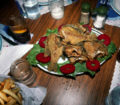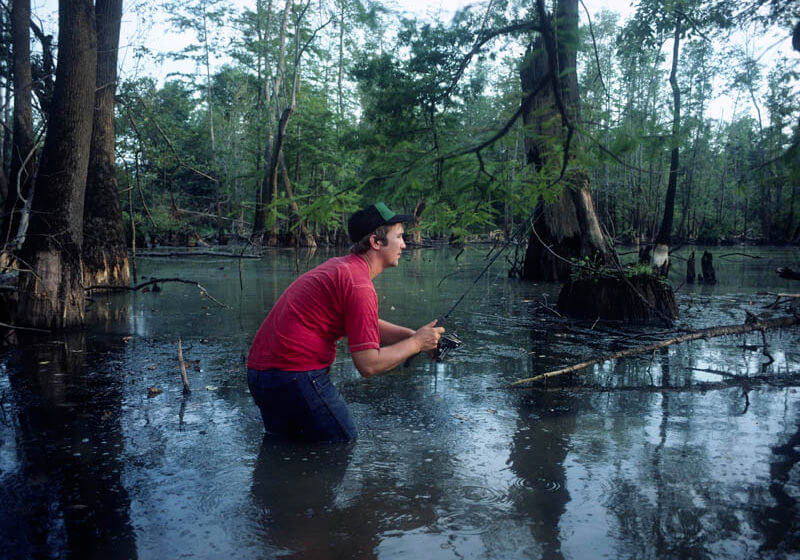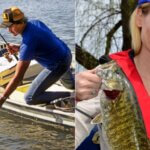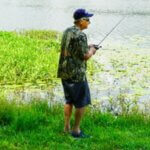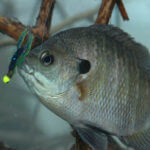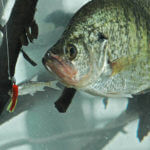Editor’s Note: Most fishermen, especially those in the Deep South, will name May as the month for catching big bream, and particularly the time around the full moon in May. But, to catch bluegills that weigh almost 5 pounds, certain conditions have to come together to produce a new world-record bluegill. Just like you can’t take a trophy whitetail, if a trophy whitetail doesn’t live on the property you hunt, the same is true for catching monster-sized bream. This week let’s look at what ingredients must come together to produce a big bream, which for most of us would be a 1-1/2 to 2-pounder.
 Bang a Bed:
Bang a Bed:
Most anglers face a problem with big-bream fishing. What do you do when the bream stop biting? In the spring of the year when bream are bedding, a good fisherman often can limit-out on one bream bed, if he knows about the bedding habits of bream and how to work with the fish. Bream usually bed in a half circle from the bank, while others will be further-out in the water. The temptation for most anglers is to try for the fish they can see close to the bank. However, this error may cost them their limit. A hooked bream usually will run for deep water. If a bluegill is hooked close to the shore, the fish will run-through several-other beds before it reaches deep water. When that happens, the fish on those beds are spooked and leave. After this process is repeated several times, most of the bedding bream will have left an area. Then you’ll only have an opportunity to take a few bank bream from that large bed.
To solve this problem of spooking the bedding fish, work with the bream and not against them. When you locate a bream bed, start casting in front of the fish you can see hoping to catch the bream bedding on the outside edge of the school. Then, when a fish is hooked and runs to deep water, it won’t disturb the other bedding bream. As you catch the outside fish, gradually work your way into the bank bream. This pick-off method will help you to systematically work a bream bed, taking more fish with less running. Besides the pick-off method, another key to catching trophy bream is to have more than one bed spotted. When the action on the bream bed stops, move to another. If the second bed fails to produce, return to the first. Back-and-forth bed-banging can lead to your landing limits of bream.
 Bottom Mop:
Bottom Mop:
Although many outdoorsmen seem to think bream die after the warm rays of the summer sun hide from the biting winds of the winter weather, bream can be taken in the wintertime. Often, cold-water bluegills are harder to find, but mopping the bottom gets results. By dragging red worms across the bottom of a pond, a river or a creek that you know contains big bream, you can have pole-bending bluegill action all winter long.
 Jig:
Jig:
Longtime, avid bream fisherman, Benny Meadows, prefers to catch his bluegills on small 1/16-ounce jigs. “I believe you can catch as many, if not more, bluegills on small, light jigs than you can on live bait,” Meadows reports. “If you‘ll fish 4-pound-test line, these little jigs will sail through the water. Because they’re small, they’ll cause bluegills to bite often when nothing else will.” To catch gills on these small baits, Meadows snaps a round bobber onto his line – 2 to 3 feet up the line – depending on the depth of the water. The bobber serves two functions by providing the weight needed for casting and suspending the jig at the depth where the fish are holding. Meadows uses a very slow, steady retrieve to attract the bites.
“When the fish are in a feeding mood, the slower you retrieve the bait, the more likely they are to hit it,” Meadows commented. “I’ll often let the cork sit still on the water. Although the jig doesn’t appear to be moving, there’s almost always a little breeze or a slight wave action that will cause the cork to move only slightly, making the jig appear to be quivering in the water much like a minnow that’s holding suspended and only barely moving its fins. If you’ve ever noticed fish in an aquarium, you’ll see that oftentimes they’ll swim very little but instead seem to hold in different places, keeping their balance steady in the water by moving their fins slightly. When a bluegill sees a jig mimicking a minnow and offering an easy meal it doesn’t have to chase, many times the fish will attack.”
 Another delicious recipe for preparing bream is Bream Bubbles.
Another delicious recipe for preparing bream is Bream Bubbles.
Bream Bubbles
2 cups bream, cooked and flaked
2 cups prepared mashed potatoes
2 egg substitute (1/2 cup)
¼ cup onions
2 Tablespoons parsley, finely chopped
salt and pepper to taste
all purpose breading mix
vegetable oil for frying
seafood cocktail sauce
Fill a deep saucepan or a fryer half full of oil. Heat oil to 375 degrees. Combine all ingredients except breading mix, and roll into small balls. Roll the balls in breading mix. Deep fry until golden brown. Drain on absorbent paper, and serve immediately with seafood cocktail sauce. (This dish is a delicious appetizer or main dish.)
Filleting a bluegill: https://www.facebook.com/murray.ragan/videos/2166724223418205
 To learn about preparing, caring for and cooking fresh fish, check out John E. Phillips’ cookbook, “The Best Wild Game and Seafood Cookbook Ever,” available in Kindle and print versions, at http://amzn.to/WkbLRg. For information on any type of fishing, visit https://johninthewild.com/books.
To learn about preparing, caring for and cooking fresh fish, check out John E. Phillips’ cookbook, “The Best Wild Game and Seafood Cookbook Ever,” available in Kindle and print versions, at http://amzn.to/WkbLRg. For information on any type of fishing, visit https://johninthewild.com/books.


